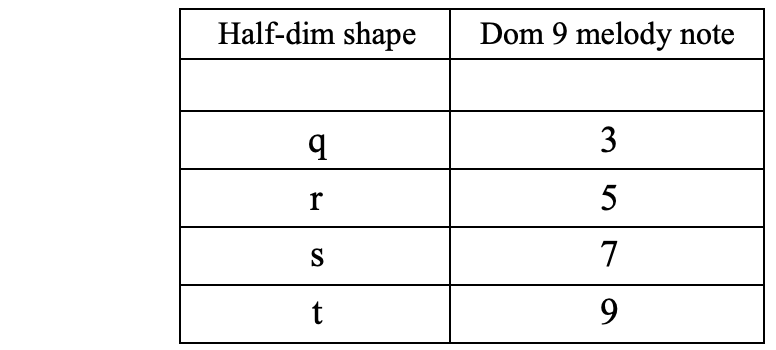Music theory home
Half diminished forms on guitar
The half-diminished, also called minor seventh flat five, (m7(b5) in shorthand), and often written in jazz notation as ø, is a flexible chord type. It is a diminished seventh with one note raised. Its primary function is as the ii chord in a minor ii V i progression, but it can also be used in other contexts. Here are the main ones, with the description in relation to any given m7b5 chord:
As a minor sixth chord from the third (the first inversion of a m7b5).
Bø = Dm6As an upper-structure substitution for a dominant chord with raised fifth and lowered ninth (altered dominant) whose root note is one whole tone higher than the root of the m7b5.
Bø = C#7 #5 b9As an upper-structure substitution for a ninth chord a major third below the root.
Bø = G9
In functional harmony, half-diminished forms crop up in major-based diatonic progressions, as well as melodic minor substitutions for 9#11 and altered dominant chords. The forms I listed above are derived from melodic minor substitutions.
The purpose of this essay is to pinpoint the ways to approach the half-diminished on two sets of adjacent four strings, learn their forms, and get better at recognising where these primary three substitutions can be used in a musical context. I chose to concentrate on adjacent strings because it makes the root note less obvious; guitarists often voice half diminished chords on strings 1, 2, 3 and 5, or on 2, 3, 4 and 6, with the bass note on the lower string. I won't be using these voicings here.
Clearly, the half-diminished has four inversions. Instead of moving the same chord up the neck, I choose to keep the same note at the top. I find it easier to memorise the shapes this way, because when playing chord-melody, I use the melody note's relation to the underlying chord as reference.
First, the top four strings of the guitar:

And also the middle four strings:

I give the voicings letter names because I want to draw attention to the fact that they are the same, even though the shapes on the fretboard are different, depending on which strings are used; and also because the name of the chord in question depends on the context.
Some observations about the shapes, and how to remember them:
q - shapes look like m6 chords from the lower string. Q is for Quite easy.
r - shapes are the easiest to see because the root note of the ø is in the bass. R is for Root!
s - shapes are wider: S stands for Spider! (at least if you don't barre the version on strings 1-4)
t - shapes "stick out" on the 1st string, to the right. T is for toe. Maybe?
In order to practice and recognise these forms, I use a substitution for a minor ii V i progression. I think the following sequences sound most natural, starting from each of the four forms in turn:

Obviously other solutions are possible, so by all means make your own!
Anyway, here are these progressions in musical notation:

Worthy of note: When these shapes are used as substitutions for the altered dominant chord, it's useful to have a way of remembering what melody notes they have on top.

Learning to recognise and transpose these shapes at will is the goal. Finding some minor-key tunes and applying these voicings as much as possible is one approach. Another is to take them around the cycle of fifths, making sure to keep logical voice-leading and avoiding jumps. Here is one way to start, using just two of the sequences, transposed every three bars.

Finally, we should consider the half-diminished as a rootless voicing for a dominant ninth chord.
